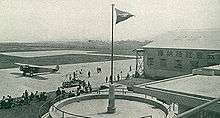Fokker Super Universal
| Super Universal | |
|---|---|
.jpg) | |
| Restored Fokker Super Universal at the Western Canada Aviation Museum in Winnipeg, Manitoba. | |
| Role | Airliner |
| Manufacturer | Fokker-America Canadian Vickers |
| First flight | March 1928 |
| Number built | ca. 200 |
| Developed from | Fokker Universal |
| Variants | Nakajima Ki-6 |
The Fokker Super Universal was an airliner produced in the United States in the late 1920s, an enlarged and improved version of the Fokker Universal, fitted with cantilever wings and an enclosed cockpit. It was subsequently also manufactured under licence in Canada, and in Japan as the Nakajima Ki-6.
Design and development
The Super Universal was a conventional, high-wing cantilever monoplane with a fully enclosed flight deck and cabin and a fixed undercarriage. Improvements over its forerunner included an enclosed cockpit and a new wing that eliminated the requirement for struts, bringing it in line with the rest of Fokker's designs. The preceding Fokker Universal was built with an open cockpit but many were converted.[1]
Construction was as per standard Fokker practice, with the wing being made almost entirely of wood with two main spars and light ribs covered in thin sheets of plywood. The fuselage was built up from welded steel tubes, largely cross-braced with wires. Fairings, the floor and an internal bulkhead separating the pilot from the cabin were wood. A triangular-shaped door gave the pilot access to the cabin. The tail was also built up from steel tubing but used no internal bracing. The main structural members were larger diameter tubes, while smaller tubes gave the structure a small degree of camber. The standard undercarriage consisted of a tailskid with divided main gear legs sprung with bungee cords and attached to the wings and the fuselage, but floats or skiis could also be fitted.
Operational history
The Super Universal was received enthusiastically in the marketplace, selling better than any other of Fokker-America's designs (some 80 aircraft), and required the company to expand its factory space to meet demand.[1] A further 15 aircraft were built by Canadian Vickers, and around 100 were built by Nakajima with some of these Japanese aircraft seeing military service as the Ki-6. The United States Navy also evaluated the Super Universal for military service, under the designation XJA-1, but decided not to purchase the type (the JA designation was later reused for the Noorduyn Norseman). The Fokker Universal was popular as a bush plane and many found their way into the Canadian north.

The first production Super Universal was named the Virginia by Richard E. Byrd and taken to the Antarctic in 1928. This aircraft was damaged after being ripped from its tiedowns and thrown backwards over one kilometre in winds estimated to have been at least 150 mph, and was abandoned, although Byrd subsequently revisited it to salvage useful parts.
Survivors
In 1998, a Super Universal originally used for mineral exploration in Canada's north was restored to airworthy condition in Manitoba, and after being flown for a few years was placed on display at the Western Canada Aviation Museum in 2005. Byrd's Fokker Universal was rediscovered by a New Zealand expedition in 1987 and the Antarctic Aviation Preservation Society intends to salvage and restore it.
Variants
- XJA-1
- A Super Universal evaluated by the United States Navy
- Nakajima Super Universal
- Civilian transport
- Ki-6 (Army Type 95 Training Aircraft)
- Military transport for the IJAAF
- Nakajima-Fokker Super Universal
- Nakajima-Fokker Ambulance Aircraft
- Nakajima Navy Fokker Reconnaissance Aircraft
- Short designation C2N1 and C2N2
- C2N1 (Navy land-based reconnaissance aircraft)
- Military transport for the IJN
- C2N2 (Navy reconnaissance seaplane)
- Military transport for the IJN
- Manshū Super Universal
- Civil and military transport built in Manchukuo (Manchuria)
Operators
Civil
- Canadian Airways
- Canadian Vickers
- Northern Transportation Company
- Starratt Airways
- Western Canada Airways
- Byrd Antarctic Expedition
- Midcontinental Air Express
- Standard Air Lines
- National Parks Airways
- Universal Air Lines
Military
Specifications
Data from Pioneering in Canadian Air Transport[1]
General characteristics
- Crew: two
- Capacity: six passengers
- Length: 36 ft 11 in (11.25 m)
- Wingspan: 50 ft 8 in (15.44 m)
- Height: 9 ft 1 in (2.77 m)
- Wing area: 370 ft2 (34.3 m2)
- Empty weight: 3,250 lb (1,474 kg)
- Gross weight: 5,550 lb (2,517 kg)
- Powerplant: 1 × Pratt & Whitney Wasp B, 450 hp (336 kW)
Performance
- Maximum speed: 138 mph (222 km/h)
- Range: 680 miles (1,100 km)
- Service ceiling: 19,340 ft (5,900 m)
- Rate of climb: 950 ft/min (4.8 m/s)
References
- Notes
- Bibliography
- Dierikx, Marc. Fokker: A Transatlantic Biography. Washington, D.C.: Smithsonian Institution Press, 1997. ISBN 1-56098-735-9.
- Molson, K.M. Pioneering in Canadian Air Transport. Winnipeg, Manitoba, Canada: James Richardson & Sons, Ltd., 1974. ISBN 0-919212-39-5.
- Nevin, David. The Pathfinders (The Epic of Flight Series). Alexandria, Virginia: Time-Life Books, 1980. ISBN 0-8094-3256-0.
- Postma, Thijs. Fokker: Aircraft Builders to the World. London: Jane's, 1979. ISBN 978-0-531-03708-9.
- Seagrave, Sterling. The Bush Pilots (The Epic of Flight Series). Alexandria, Virginia: Time-Life Books, 1983. ISBN 0-8094-3312-5.
- Taylor, Michael J. H. Jane's Encyclopedia of Aviation. London: Studio Editions, 1989. p. 410.
- World Aircraft Information Files. London: Bright Star Publishing, File 894, Sheet 44.
External links
| Wikimedia Commons has media related to Fokker Super Universal. |
- Antarctic Aviation Preservation Society
- Fokker Super Universal CF-AAM Returns to Yukon Territory
- Western Canada Aviation Museum